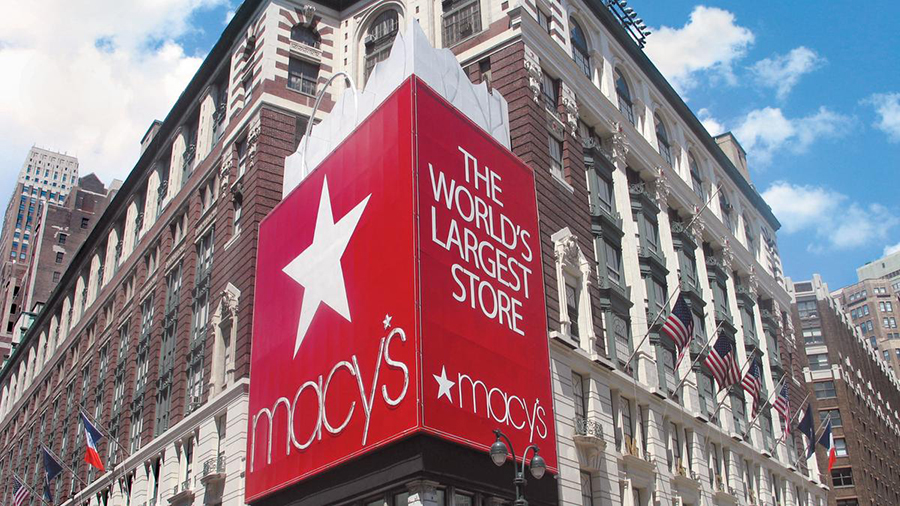Macy’s, Inc. slightly improved its outlook for the year as third-quarter results topped expectations as inventory and margins improved. Sales were down 7 percent in the third quarter.
EPS came in at 21 cents a share against break-even results expected on average by analysts. Revenues are expected to total $4.86 billion versus Wall Street’s consensus estimate of $4.82 billion
“I’d like to thank our teams for executing well during the quarter. We delivered better-than-expected top and bottom-line third-quarter results and are entering the holiday period in a healthy inventory position. Our portfolio of nameplates is leading gift-giving destinations across the value spectrum offering exclusive products. We have refined our gift assortment, simplified our promotions and improved our shopping experience,” said Jeff Gennette, chairman and chief executive officer of Macy’s, Inc. “Looking forward we have strong continuity with Tony Spring transitioning to CEO in February and I am confident he and our leadership team will guide Macy’s, Inc. to sustainable long-term profitable sales growth in the future.”
Third Quarter Highlights
Comparisons are to the third quarter of 2022 unless noted otherwise. Comparisons to 2019 are provided, where appropriate, to benchmark performance. Please refer to note 2 within the financial tables regarding reclassifications of certain prior year metrics.
- Diluted earnings per share of 15 cents and Adjusted diluted earnings per share of 21 cents.
- This compares to diluted earnings per share of 39 cents and Adjusted diluted earnings per share of 52 cents in the third quarter of 2022.
- Net sales of $5 billion, down 7 percent versus the third quarter of 2022.
- Brick-and-mortar sales decreased 7 percent versus the third quarter of 2022.
- Digital sales decreased 7 percent versus the third quarter of 2022.
- Comparable sales down 7.0 percent on an owned basis and down 6.3 percent on an owned-plus-licensed basis.
- Highlights of the company’s nameplates include:
- Macy’s comparable sales were down 7.6 percent on an owned basis and down 6.7 percent on an owned-plus-licensed basis.
- Approximately 41.3 million active customers shopped the Macy’s brand, on a trailing twelve-month basis.
- Star Rewards program members made up approximately 72 percent of Macy’s brand comparable owned-plus-licensed sales on a trailing twelve-month basis.
- The Macy’s nameplate saw strength in beauty, particularly fragrances and prestige cosmetics, women’s career sportswear, men’s tailored and off-price with Backstage, while women’s casual sportswear, big-ticket and handbags were challenged.
- Bloomingdale’s comparable sales on an owned basis were down 3.2 percent and on an owned-plus-licensed basis were down 4.4 percent.
- Approximately 4.0 million active customers shopped the Bloomingdale’s brand, on a trailing twelve-month basis.
- The Bloomingdale’s nameplate saw strength across beauty, women’s contemporary apparel, shoes and Bloomingdale’s outlet locations, while men’s, home and designer handbags were soft.
- Bluemercury comparable sales were up 2.5 percent on an owned basis.
- Approximately 683,000 active customers shopped the Bluemercury brand, on a trailing twelve-month basis.
- The Bluemercury nameplate saw strength in skincare and color cosmetic categories.
- Macy’s comparable sales were down 7.6 percent on an owned basis and down 6.7 percent on an owned-plus-licensed basis.
- Other revenue of $178 million, a $59 million decrease.
- Represented 3.7 percent of net sales, down from 4.5 percent in the prior year period.
- Performance driven largely by net credit card revenue which declined year-over-year due to the expected impact of higher delinquency rates and bad debt levels within the portfolio.
- Inventory turnover, on a trailing twelve-month basis, was up 1 percent to 2022 and up 16 percent to 2019.
- Merchandise inventories were down 6 percent year-over-year and down 17 percent to 2019, reflecting ongoing disciplined inventory management.
- Gross margin rate for the quarter was 40.3 percent, up from 38.7 percent in the third quarter of 2022.
- Merchandise margin improved 110 basis points, due to lower permanent markdowns within the Macy’s brand, as well as improved freight expense, partially offset by planned changes in Macy’s category mix.
- As disclosed in the second quarter, merchandise margin also reflects the shift in the timing of the company’s shortage recognition informed by a June physical inventory count in certain categories.
- Delivery expense as a percent of net sales improved 50 basis points from the prior year reflecting improvements in merchandise allocation resulting in reductions in packages per order and distance traveled.
- SG&A expense of $2.0 billion, a $48 million decrease.
- SG&A expense as a percent of total revenue was 40.5 percent, 230 basis points higher compared to the third quarter of 2022, reflecting the decline in sales year-over-year.
- SG&A expense dollars benefited from the company’s commitment to ongoing expense discipline. SG&A expense dollars were also favorable due to a roughly $10 million timing shift of certain previously estimated expenses from the third quarter to the fourth quarter.
2023 Guidance
The company updated its annual sales and earnings outlook to reflect third-quarter results. The outlook also reflects the risks associated with an uncertain macroeconomic climate and the related pressures on consumers and provides flexibility to respond to intra-quarter demand trends.
The full updated outlook for 2023, presented on a 53-week basis unless otherwise noted, can be found in the presentation posted to macysinc.com/investors.
Updated guidance for the year calls for:
- Sales in the range of $22.9 billion to $23.2 billion (prior, $22.8 billion to $23.2 billion)
- Comparable owned-plus-licensed sales change (52-week basis): Down 7 percent to down 6 percent versus 2022 (prior, down 7.5 percent to down 6 percent versus 2022)
- Adjusted diluted earnings per share: $2.88 – $3.13, midpoint, $3.00 (prior, $2.70 to $3.20, midpoint, $2.95)
Photo courtesy Macy’s
















